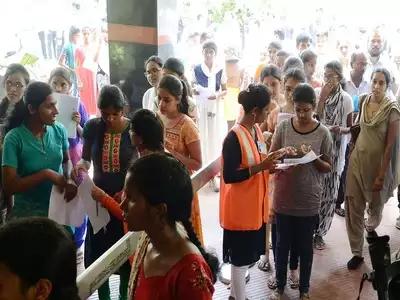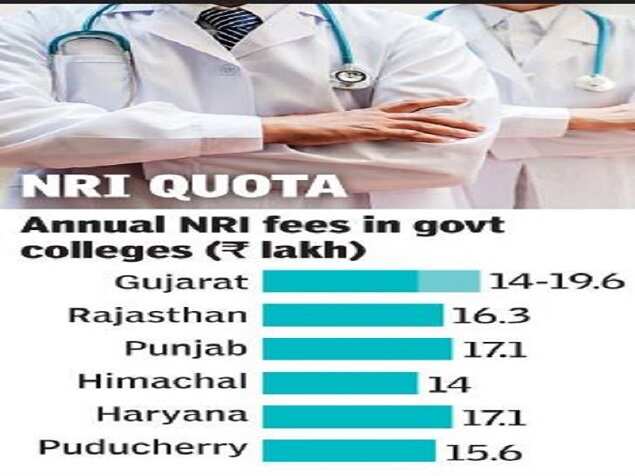Government medical colleges are 'selling' seats now

If you’re a resident Indian with poor NEET scores, getting admission in a government medical college is a pipedream, but if you are an NRI, you have a good shot at it.
The reason is that it is not just private colleges commercializing medical education. Some state governments too have joined the bandwagon in the name of making their colleges self-financing. So, 3%-15% seats are set aside for NRIs and some even have “management quotas”.

Five states — Gujarat, Rajasthan, Punjab, Haryana and Himachal Pradesh -- and Puducherry have government medical colleges with NRI quotas. Unlike caste-based quotas, which are to compensate for historical deprivation and backwardness, the NRI quota is for being able to charge lakhs as fees. Most states claim the quota is to mobilise funds for maintenance and infrastructure, something that would earlier have come from the health budget.
Gujarat has the highest number of NRI seats, 241, followed by Rajasthan with 212, Punjab with 41, Puducherry with 22, Himachal Pradesh with 20 and Haryana with 15 seats.
NRI seats are open not only to NRIs but also those they sponsor. Thus, many can use this quota if they have a brother, sister or parent who is an NRI willing to give an undertaking to sponsor the entire course fee. If a student has no parents or is taken as a ward by near relatives, even NRI uncles, aunts or grandparents can be sponsors. There have been several cases of candidates faking eligibility, prompting greater scrutiny of candidates’ NRI claims.
A look at over 1,900 NRI candidates admitted in 2016shows that almost three-quarters were unreserved category students, barely 3% belonged to SC/STs and rest were OBCs. While the average NEET score of government quota students including reserved SC, ST and OBC seats in 2016 was 472.5, that of NRI candidates in private colleges was 220.8 and of those in government colleges was 339.6.
The NRI quota fees in government colleges range from Rs 14 lakh to almost Rs 20 lakh per annum. While this is very high compared to the fee charged for the other government seats in most of these colleges (Rs 25,000 to Rs 1 lakh per annum), it is much cheaper than the Rs 30 lakh per annum charged by most private colleges for NRI seats.
Andhra Pradesh too earlier had NRI seats in government colleges, but has discontinued this. Madhya Pradesh had about 28 NRI seats in government colleges till 2016, but discontinued the practice in the face of public protests. Last year, the Karnataka government had toyed with the idea of starting an NRI quota in government colleges, but dropped the idea after student organisations threatened agitations.
Former vice chancellor of Rajiv Gandhi University of Health Sciences and eminent cardiologist Dr KS Ravindranath explained that the reason for opposing NRI quota in Karnataka government colleges was because it would encroach on seats for poor meritorious students. The government ought to allocate more, but there are never sufficient funds to provide facilities for sports, research, simulation lab etc, he added.
Former joint director of medical education in Madhya Pradesh, NM Shrivastava questioned the concept of using NRI seats to generate funds to improve the college. “The money earned from NRI seats was small in comparison to the resources required for running a college. Moreover, government colleges are meant for public welfare, for poor to get free treatment and for meritorious students. They are not meant to make money. Free education is the government’s job in a democratic welfare state. That’s why the government decided to put an end to NRI quota in MP,” explained Shrivastava.
(with inputs from Bharat Yagnik in Ahmedabad, Initshab Ali in Jaipur, Shimona Kanwar in Chandigarh and Pushpa Narayan in Chennai)
Source: Times of India





























































Comments
Test name February 19, 2016 Reply
There are many variations of passages of Lorem Ipsum available, but the majority have suffered alteration in some form, by injected humour, or randomised words which don't look even slightly believable. If you are going to use a passage of Lorem Ipsum, you need to be sure there isn't anything embarrassing hidden in the middle of text.
Test name February 19, 2016
Lorem ipsum dolor sit amet, consectetur adipiscing elit, sed do eiusmod tempor incididunt ut labore et dolore magna aliqua.
Test name February 19, 2016Reply
Lorem ipsum dolor sit amet, consectetur adipiscing elit, sed do eiusmod tempor incididunt ut labore et dolore magna aliqua. Lorem ipsum dolor sit amet, consectetur adipiscing elit, sed do eiusmod tempor incididunt ut labore et dolore magna aliqua.